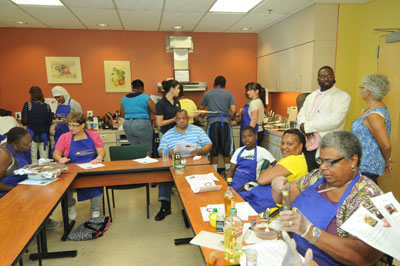Skip the Salt: Seasoning Food with Herbs and Spices
October 9, 2013
 At 11th Street Family Health Services of Drexel University, patients and community members are learning to cut down their salt intake by seasoning their food with herbs and spices. Here, 11th Street staff experts share their knowledge and recommendations. Jennifer A. Warshaw is the Health Educator and Outreach Coordinator at the health center.
At 11th Street Family Health Services of Drexel University, patients and community members are learning to cut down their salt intake by seasoning their food with herbs and spices. Here, 11th Street staff experts share their knowledge and recommendations. Jennifer A. Warshaw is the Health Educator and Outreach Coordinator at the health center.
Chartings: Why do we feel compelled to put salt on our food?
Jennifer Warshaw: It’s often on the table and within reach. Our taste buds are used to high salt content in our foods already, so not adding salt will make food taste bland and if it doesn’t taste good, we won’t eat it. Salt is one of the five basic tastes that our taste buds encounter. People with more “salty” taste buds will crave foods with salt even more.
Chartings: Are there any salt alternatives or other ingredients we should explore to flavor our food?
JW: “No-salt” substitutions are available. However, many contain potassium chloride which people who have kidney problems or who are taking certain medications, like diuretics or other medications for high blood pressure, should be cautious with. There are also “low salt” and light seasoning mixes, but you should read the amount of sodium on the nutrition label to be sure you are reducing the amount of sodium in your recipe, as many still have MSG-monosodium glutamate. No-salt herb and spice mixes, like Mrs. Dash, offer a lot of variety in flavors without any salt or salt alternatives added. These as well as other dried herbs and spices should be used in place of salt or to help reduce the amount of salt added to meals.
Chartings: What are the potential health benefits of having a diet low in salt?
JW: Improved blood pressure, improved effectiveness of blood pressure medications, and reduced bloating and swelling associated with high salt intake.
Chartings: What are the typical recommendations for the amount of salt we should add to our food?
JW: The Dietary Guidelines for Americans recommends limiting sodium to less than 2300 milligrams (mg) a day, or less than 1500 mg if you are over 51 years old, have high blood pressure, diabetes or chronic kidney disease. Although there has been much controversy over these “blanket” recommendations, the average American’s sodium intake is about 3400 mg per day, well over both of these recommendations.
Chartings: Do you address the topic of salt and seasoning in cooking classes at 11th Street?
JW: We focus a lot on taking traditional meals and recipes and making them healthier by reducing ingredients like sodium, or using substitutions like Mrs. Dash or other herbs and spices. This allows us to show patients that the foods we love still taste delicious even when adapted to be healthier. We have discussion topics that are geared around the ingredients we are using as well as the alterations we are making to traditional recipes.
11th Street’s Fitness and Wellness Trainer, John Kirby, also weighed in on the importance of considering both nutrition and exercise together to foster wellbeing. He underscores the value of having assets like Jennifer Warshaw at 11th Street Family Health Services.
Chartings: Why is it important to focus on both nutrition and fitness and not just one or the other?
John Kirby: Focusing on both together helps you reach you goals faster and keep your body in good working condition.
Chartings: How does having knowledgeable staff like Jennifer complement the work you do in the fitness center at 11th Street?
JK: Having Jennifer helps to bring the messages full circle that I give to patients about how diet and exercise work in tandem. When speaking with a patient who has questions about dietary changes that are beyond my scope, I am able to refer them to a specialist who can give him/her the answers he/she is looking for. Jennifer is sometimes able to stop what she is doing and meet face-to-face with the patients, which can sometimes be very effective at keeping them true to the lifestyle goals we’re looking to achieve.
Chartings: Can you describe a “success story” from 11th Street’s Biggest Loser program where both the fitness and nutrition components generated powerful results for a patient?
JK: Our most recent Biggest Loser competition winner lost 17.4 pounds during the 8 week session. She would often take the dietary lessons and tips we gave during the nutrition class and incorporate them into her life at home immediately. One of the most important changes she made early in the competition was eating breakfast daily. Whether it was a smoothie, a plate of fruit and yogurt or a more traditional breakfast with eggs and vegetables, she made an effort to eat breakfast on a consistent basis. This allowed her to have more energy in the morning to fuel her hour of exercise that she committed to 2-3 times a week.
During part of the year, 11th Street patients have access to fresh herbs growing in the health center’s urban garden. “These add color and flavor to our recipes,” Jennifer Warshaw said. Fresh herbs are available year-round in grocery stores, and Warshaw advocates for using them as flavor agents in cooking. “We regularly use fresh oregano, parsley, basil, thyme, rosemary and cilantro and also use seasonal mint and sage,” she said. “A little known fact about herbs: You will need to use more fresh herbs than dried, as dried herbs have a more concentrated, stronger flavor. Keep them in an airtight container and store them away from light and heat to preserve freshness!”